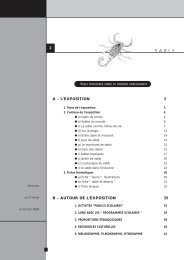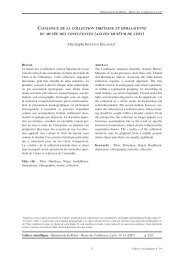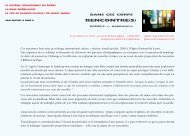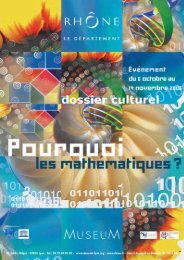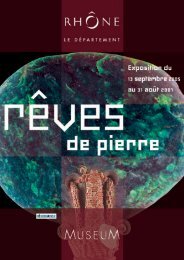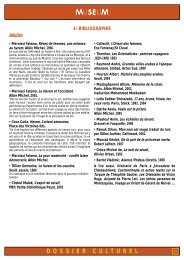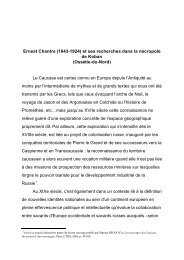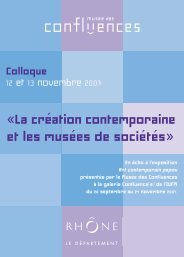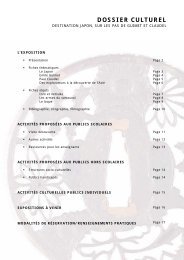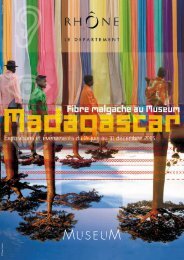Télécharger le fascicule 12 - 2007 en entier - musée des Confluences
Télécharger le fascicule 12 - 2007 en entier - musée des Confluences
Télécharger le fascicule 12 - 2007 en entier - musée des Confluences
Create successful ePaper yourself
Turn your PDF publications into a flip-book with our unique Google optimized e-Paper software.
C<strong>en</strong>tre de Conservation et d'Etude <strong>des</strong> Col<strong>le</strong>ctions<br />
DESCRIPTION<br />
Mâ<strong>le</strong>s et femel<strong>le</strong>s id<strong>en</strong>tiques, exceptés par <strong>le</strong>ur tail<strong>le</strong>.<br />
L’espèce semb<strong>le</strong> être très variab<strong>le</strong> <strong>en</strong> <strong>des</strong>sins et cou<strong>le</strong>urs,<br />
sur tous <strong>le</strong>s spécim<strong>en</strong>s examinés. L’élytre est jaune à<br />
orange-rouge avec <strong>des</strong> lignes et taches brun-noir variab<strong>le</strong>s<br />
sur approximativem<strong>en</strong>t <strong>le</strong>s deux tiers depuis la base,<br />
l’apex est brun foncé avec plusieurs petites taches blanches<br />
ron<strong>des</strong> de tail<strong>le</strong>s différ<strong>en</strong>tes. Environ la moitié de<br />
l’ai<strong>le</strong> postérieure depuis la base est de cou<strong>le</strong>ur orange à<br />
rouge translucide, <strong>le</strong> bord externe et l’apex sont brun<br />
foncé. Sur trois <strong>des</strong> spécim<strong>en</strong>s étudiés, <strong>le</strong>s nervures à<br />
l’intérieur de la zone rouge-orange sont soulignées de<br />
brun foncé, mais l’allotype femel<strong>le</strong> ne prés<strong>en</strong>te pas ces<br />
nervures foncées. La tête, <strong>le</strong> corps et <strong>le</strong>s pattes sont ocre<br />
à vert clair selon <strong>le</strong>s exemplaires. Le développem<strong>en</strong>t<br />
céphalique est plutôt court et il est même de loin <strong>le</strong> plus<br />
court de toutes <strong>le</strong>s espèces connues du g<strong>en</strong>re ; il est fin,<br />
non dilaté à l’apex et modérém<strong>en</strong>t recourbé vers <strong>le</strong> haut<br />
dans sa moitié apica<strong>le</strong> ; un petit d<strong>en</strong>ticu<strong>le</strong> dressé vers <strong>le</strong><br />
haut est prés<strong>en</strong>t à mi-distance <strong>en</strong>tre <strong>le</strong>s yeux et l’apex.<br />
Tail<strong>le</strong> du développem<strong>en</strong>t céphalique (de l’avant <strong>des</strong><br />
yeux jusqu’à l’apex) : 3,5 mm pour <strong>le</strong>s 4 spécim<strong>en</strong>s.<br />
Envergure : mâ<strong>le</strong> 37 à 38 mm., femel<strong>le</strong> 41 à 43 mm.<br />
DESCRIPTION<br />
Ma<strong>le</strong> and fema<strong>le</strong> id<strong>en</strong>tical except for their size. The<br />
species seems to be quite variab<strong>le</strong> in colors and <strong>des</strong>igns,<br />
on all examined specim<strong>en</strong>s. The elytron is yellow to<br />
reddish orange color with variab<strong>le</strong> dark brown to black<br />
lines and spots over approximately its first two thirds<br />
from the base, the apex is dark brown with<br />
several white round maculae of differ<strong>en</strong>t sizes. About<br />
half of the posterior wing starting at the base is orange<br />
to red transluc<strong>en</strong>t color, the external border and the<br />
apex are dark brown. On three specim<strong>en</strong>s the veins<br />
inside the orange-red base are underlined with that<br />
same dark brown color, whi<strong>le</strong> the allotype fema<strong>le</strong> is<br />
c<strong>le</strong>ared of those dark veins. Head, body and <strong>le</strong>gs are<br />
ochre to light gre<strong>en</strong>. The cephalic developm<strong>en</strong>t is rather<br />
short, actually by far the shorter among all other species<br />
of the g<strong>en</strong>us, fine, not dilated at the apex and moderately<br />
b<strong>en</strong>t upwards. A small spine is erected upwards at<br />
about half distance from the eyes to the apex.<br />
Size of cephalic developm<strong>en</strong>t (from the front of the<br />
eyes to the apex) is 3.5 mm on all 4 specim<strong>en</strong>s<br />
Wingspan: ma<strong>le</strong> 37 to 38 mm., fema<strong>le</strong> 41 to 43 mm.<br />
DISCUSSION<br />
Cette nouvel<strong>le</strong> espèce se différ<strong>en</strong>cie au premier regard<br />
de tous <strong>le</strong>s autres Saiva connus, bi<strong>en</strong> que <strong>le</strong>s <strong>des</strong>sins et<br />
la coloration soi<strong>en</strong>t assez proches de ceux de Saiva<br />
ishiharai (Sato & Nagai, 1994) ou Saiva formosana<br />
Kato 1929. Son développem<strong>en</strong>t céphalique est s<strong>en</strong>sib<strong>le</strong>m<strong>en</strong>t<br />
différ<strong>en</strong>t et de loin <strong>le</strong> plus court de toutes <strong>le</strong>s<br />
autres espèces du g<strong>en</strong>re, bi<strong>en</strong> que sa forme ainsi que<br />
cel<strong>le</strong> <strong>des</strong> élytres soi<strong>en</strong>t caractéristiques du g<strong>en</strong>re.<br />
Etymologie : cette nouvel<strong>le</strong> espèce est dédiée à Karim<br />
Bujang, Ministre du Tourisme, de la Culture et de<br />
l’Environnem<strong>en</strong>t du Sabah, Est Malaisie.<br />
DISCUSSION<br />
The new species looks quite differ<strong>en</strong>t of all other<br />
known Saiva, though its coloration and <strong>des</strong>igns are<br />
close to Saiva ishiharai (Sato & Nagai) 1994 or Saiva<br />
formosana Kato 1929, its head developm<strong>en</strong>t is quite<br />
differ<strong>en</strong>t and by far the shortest among all other<br />
species of the g<strong>en</strong>us, though its shape and shape of the<br />
elytra are characteristic of the g<strong>en</strong>us.<br />
Etymology: this new species is especially dedicated to<br />
Datuk Karim Bujang who is the Deputy Minister of<br />
Tourism, Culture and Environm<strong>en</strong>t of Sabah, East Malaysia.<br />
RÉFÉRENCES BIBLIOGRAPHIQUES<br />
KATO M. (1929) – Descriptions of some Formosan<br />
Homoptera. Transactions of Natural History<br />
Society of Formosa, 19 : 540-551.<br />
LALLEMAND<br />
V. (1963) – Revision <strong>des</strong> Fulgoridae<br />
(Homoptera). Deuxième partie : Faunes asiatique<br />
australi<strong>en</strong>ne. Mém. Inst. r. Sci. nat.<br />
Belg., 2 e série, 75, 99 pp.<br />
METCALF Z.P. (1947) – G<strong>en</strong>eral Catalogue of the<br />
Homoptera. Fascic<strong>le</strong> IV Fulgoroidea. Part 9<br />
Fulgoridae. North Carolina State Col<strong>le</strong>ge,<br />
Ra<strong>le</strong>igh, NC, USA, 276 pp.<br />
NAGAI S. & PORION T. (1996) – Fulgoridae 2.<br />
Illustrated Catalogue of the Asiatic and<br />
Australian Fauna. Editions Sci<strong>en</strong>ces Nat.,<br />
96 pp.<br />
NAGAI S. & PORION T. (2002) – Fulgoridae 2.<br />
Supp<strong>le</strong>m<strong>en</strong>t 1: New Fulgoridae from South-<br />
East Asia. Hillside Books, Canterbury, 14 pp.<br />
NAGAI S. & PORION T. (2004) – Fulgoridae 2.<br />
Supp<strong>le</strong>m<strong>en</strong>t 2: New Fulgoridae from South-<br />
East Asia. Hillside Books, Canterbury, <strong>12</strong> pp.<br />
Cahiers sci<strong>en</strong>tifiques n° <strong>12</strong><br />
6



